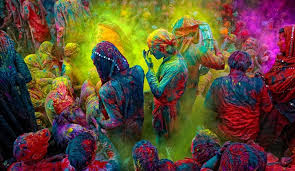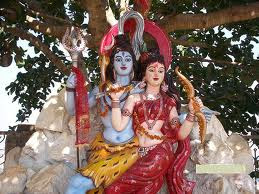Today is 18 Saptember Celebrated to Hartalika Teej Vrat and Kevda Teej.
 Hartalika Teej Vrat, also referred to as Hartalika Teej Vrat or Hartalika Vrat, is an important ritual followed in order to honor Goddess Gauri or Goddess Parvati. This vrat is observed on the 3rd day of the first fortnight in the Hindu lunar month of Bhadra. The three day festival is celebrated with utmost splendor and grandeur by both married and unmarried women. The major celebrations can be witnessed in the Indian states of Uttar Pradesh, Bihar, Jharkhand, Rajasthan, Chhattisgarh, Maharashtra and Madhya Pradesh. In Karnataka, this fast is celebrated as Swarna Gauri Vrata or Gowri Habba while, in Andhra Pradesh, it is referred to as Thadiya Gauramma Vratham. Browse further to know the detailed information on Hartalika Teej vrat and also find out how to observe it.
Hartalika Teej Vrat, also referred to as Hartalika Teej Vrat or Hartalika Vrat, is an important ritual followed in order to honor Goddess Gauri or Goddess Parvati. This vrat is observed on the 3rd day of the first fortnight in the Hindu lunar month of Bhadra. The three day festival is celebrated with utmost splendor and grandeur by both married and unmarried women. The major celebrations can be witnessed in the Indian states of Uttar Pradesh, Bihar, Jharkhand, Rajasthan, Chhattisgarh, Maharashtra and Madhya Pradesh. In Karnataka, this fast is celebrated as Swarna Gauri Vrata or Gowri Habba while, in Andhra Pradesh, it is referred to as Thadiya Gauramma Vratham. Browse further to know the detailed information on Hartalika Teej vrat and also find out how to observe it.
Today Women either gather at a nearby temple or a garden where the puja is arranged. The main puja takes place with holy offerings of flowers, sweets and coins. A semi-circle is created and an idol of Goddess Parvati is kept in the middle. A pujarin or all the ladies together narrate the holy Teej Katha. Young girls also sit to listen the auspicious katha. While listening to the katha, women are expected to put their mind and thoughts towards their soul mate.
 When the puja gets over women offer fruits, flowers and other holy items and seek blessings of Goddess Parvati for marital bliss. Another very important part of Teej Puja is the oil lamp which should be kept alight throughout the night as it is bad omen if it dies away.
When the puja gets over women offer fruits, flowers and other holy items and seek blessings of Goddess Parvati for marital bliss. Another very important part of Teej Puja is the oil lamp which should be kept alight throughout the night as it is bad omen if it dies away.
At some places, after paying homage to Goddess Parvati, women bath with red mud found on the roots of the sacred Datiwan bush. This is an act of purification. It is believed that a woman is absolved from all sins after taking this holy bath.
At the end of the day, women share their happiness and joy by dancing and singing traditional songs in praise of Lord Shiva and her consort Parvati.
Lot of activities and rituals are performed at the time of Teej Puja. Attired in traditional sarees and lehangas, women congregate in a temple to worship Parvati Ma, who took 108 births to reunite with Lord Shiva. On this day, idol of Goddess Parvati is bedecked with rich silk cloth and heavy jewelry. This day is considered very important as married women and engaged girls observe fast for long and healthy life of their husband and to-be-husband.
A small story lies behind the celebration of Hartalika Teek vrat. Legends explain that after the death of Sati Devi, Lord Shiva started ignoring the entire world, including Goddess Parvati without noticing her devoted love. In order to get her husband’s attention, Parvati underwent severe penance for several years surviving only on grass and fruits. Eventually, Lord Shiva got pleased by the love and affection of Parvati and finally accepted her. Hence, this festival is commemorated by all women, whether married or single. While the married women observe this for achieving health and happiness for their respective husbands, unmarried young girls and women observe the fast in order to be blessed with a loyal husband, like Lord Shiva.
Similar to Karwa Chauth, women observe a ‘nirjala vrata’, that is, severe fasting without eating and drinking anything. On the day of Hartalika Teej, a pandal (small puja house) is made using banana bark and leaves. Goddess Parvati is adorned with new clothes and set in the pandal. A Shivling is made from clay and placed alongside Parvati. Women beautify their hands and feet with mehndi (henna), a unique feature of Hartalika Tritiya celebrations. They dress up in new green clothes and new jewelry. In certain regions, married women visit their premarital homes and observe the fast along with their parents and other family members. They put on green bangles and a golden bindi.
Stories of Goddess Parvati and Lord Shiva are read out and listened as they are considered auspicious on this festival. In the evenings, special prayers are arranged for worshipping the deities. Thereafter, traditional songs and dances are performed which are actively participated by relatives and friends. Fresh fruits and vegetables are brought specially for this day and offered to Parvati. Special delicacies, such as rice patolis and sweets, are made on this occasion. Preparations made from coconut take special place.









.jpg)







.jpg)